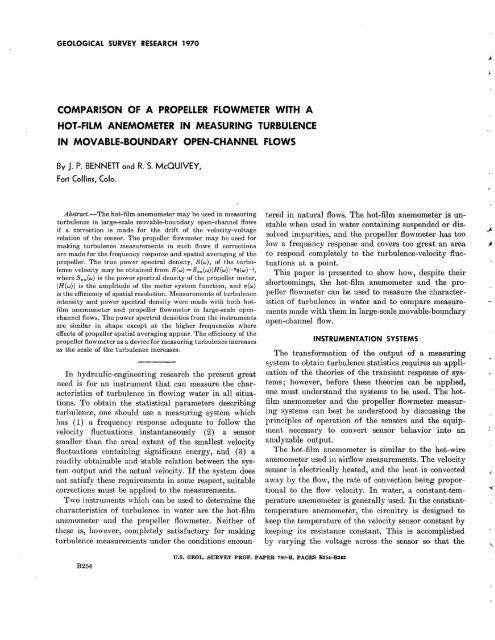RESEARCH· ·1970·
RESEARCH· ·1970·
RESEARCH· ·1970·
You also want an ePaper? Increase the reach of your titles
YUMPU automatically turns print PDFs into web optimized ePapers that Google loves.
GEO'LOGICAL SURVEY RESEARCH 1970<br />
COMPARISON OF A PROPELLER FLOWMETER WITH A<br />
HOT -FILM ANEMOMETER IN MEASURING TURBULENCE<br />
IN MOVABLE-BOUNDARY OPEN-CHANNEL FLOWS<br />
By J. P. BENNETT and R. S. McOUIVEY,<br />
Fort Collins, Colo.<br />
Abstract.-The hot-film anemometer may be used in measuring<br />
turbulence in large-scale movable-boundary open-channel flows<br />
if a correction is made for the drift of the velocity-voltage<br />
relation of the sensor. The propeller flowmeter may be used for<br />
making turbulence measurements in such flows if corrections<br />
are made for the frequency response and spatial averaging of the<br />
propeller. The true power spectral density, S(w), of the turbulence<br />
velocity may be obtained from S(w) =Soo(w) IH(w) l- 2 '17(w)- 1 ,<br />
where S 00 (w) is the power spectral density of the propeller meter,<br />
IH(w) I is the amplitude of the meter system function, and '17(w)<br />
is the efficiency of spatial resolution. Measurements of turbulence<br />
intensity and power spectral density were made with both hotfilm<br />
anemometer and propeller flowmeter in large-scale openchannel<br />
flows. The power spectral densities from the instruments<br />
are similar in shape except at the higher frequencies where<br />
effects of propeller spatial averaging appear. The efficiency of the<br />
propeller flowmeter as a device for measuring turbulence increases<br />
as the scale of the turbulence increases.<br />
In hydraulic-engineering research the present great<br />
need is for an instrument that can measure the characteristics<br />
of turbulence in flowing water in all situations.<br />
To obtain the statistical parameters describing<br />
turbulence, one should use a measuring system which<br />
has ( 1) a frequency response adequate to follow the<br />
velocity fluctuations instantaneously (2) a sensor<br />
smaller than the areal extent o£ the smallest velocity<br />
fluctuations containing significant energy, and (3) a<br />
readily obtainable and stable relation between the system<br />
output and the actual velocity. If the system does<br />
not satisfy these requirements in some respect, suitable<br />
corrections .mus.t be applied to the measurements.<br />
Two instruments which can be used to determine the<br />
characteristics of turbulence in water are the hot-film<br />
anemometer and the propeller flowmeter. Neither of<br />
these is, however, completely satisfactory for making<br />
turbulence measurements under the conditions encountered<br />
in natural flows. The hot-film anemometer is unstable<br />
when used in water containing suspended or dissolved<br />
impurities, and the propeller flowmeter has too<br />
low a frequency response and covers too great an area<br />
to respond completely to the turbulence-velocity fluctuations<br />
at a point.<br />
This paper is presented to show how, despite their<br />
· shortcomings, the hot-film anemometer and the propeller<br />
flowmeter can be used to measure the characteristics<br />
of turbulence in water and to compare measurements<br />
made with them in large-scale movable-boundary<br />
open-channel flow.<br />
INSTRUMENTATION SYSTEMS<br />
The transformation of the output of a measuring<br />
system to obtain turbulence statistics requires an application<br />
of the theories of the transient response of systems;<br />
however, before these theories can be applied,<br />
one must understand the systems to be used. The hotfilm<br />
anemometer and the propeller flowmeter measuring<br />
systems can best be understood by discussing the<br />
princi pies of operation of the sensors and the equipment<br />
necessary to convert sensor behavior into an<br />
analyzable output.<br />
The hot-film anemometer is similar to the hot-wire<br />
anemometer used in airflow measurements. The velocity<br />
sensor is ·electrically heated, and the heat is convected<br />
a·way by the flow, the rate of convection being proportional<br />
to the flow velocity. In water, a constant-temperature<br />
anemometer is generally used. In the constanttemperature<br />
anemometer, the circuitry is designed to<br />
keep the temperature of the velocity sensor constant by<br />
keeping its resistance constant. This is accomplished<br />
by varying the voltage across the sensor so that the<br />
B254<br />
U.S. GEOL. SURVEY PROF. PAPER 70o-B, PAGES B254-B262
















